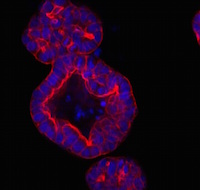Members Login

Channels
Special Offers & Promotions
Guide to Organoid Growth
AMSBIO has launched, at the ‘Frontiers in Stem Cells & Cancer' EMBL-EMBO Symposium**, a guide that illustrates a variety of organoids grown from different tissues by leading international research groups using BME 2 reduced growth factor extracellular matrix that is available from the company.
 Organoids are organ-like structures that can be formed by 3D cell culture and differentiation of stem cells or organ progenitors. Organoids are capable of recapitulating aspects of organ function in in vitro. The current research and therapeutic potential of organoids include organogenesis models, drug testing, tumor / disease models, toxicity screening, personalised medicine and regenerative medicine / organ replacement.
Organoids are organ-like structures that can be formed by 3D cell culture and differentiation of stem cells or organ progenitors. Organoids are capable of recapitulating aspects of organ function in in vitro. The current research and therapeutic potential of organoids include organogenesis models, drug testing, tumor / disease models, toxicity screening, personalised medicine and regenerative medicine / organ replacement.
BME 2 reduced growth factor has been shown to work well for growing organoids, especially using techniques based on the LGR5 stem cell marker / Wnt signalling system, pioneered by Hans Clevers and co-workers.
The guide contains published protocols and citations for organoid growth, as well as examples of the following organoid models on BME 2: Human liver (courtesy of Dr Meritxell Huch, Gurdon Institute, University of Cambridge, UK ); Mouse liver (Dr. Derk ten Berge, Erasmus MC Stem Cell Institute, Rotterdam, Netherlands); Human Colorectal Cancer (CRC) and Mouse Adenoma (Batlle Lab, IRB, Barcelona); Mouse Inestinal CRC model (Li Lab, NIMR, London, UK); Transgenic mouse intestine (Sansom Lab, Beatson Institute, Glasgow, UK); Oesophagus (Dr Mathew Garnet, Sanger Wellcome Trust Institute, Cambridge, UK); and mammary cancer (Dr Tuula Kallunki Danish Cancer Research Society Copenhagen, Denmark).
AMSBIO’s wide range of matrices and other solutions for 3D cell culture include natural hydrogels, recombinant matrices, artificial scaffolds and scaffold-free supports. Recently AMSBIO introduced two novel formulations of Basement Membrane Extract (BME2 and BME3) to address the heterogeneous nature of tissue and organ microenvironments that not only arise from organ specific stromal cells, growth factors, proteoglycans, and protein composition but also from the stiffness or tensile strength of the BME. Matrices from AMSBIO not only support cells and cell layers, but also play an essential role in tissue organization that affects cell adhesion, migration, proliferation, and differentiation. These aspects can be studied with tools from AMSBIO and the company’s experience in developing specialist matrices includes regulatory friendly solutions for regenerative medicine applications where customers are already in clinical trials.
download a copy of the Organoid Guide
Media Partners


